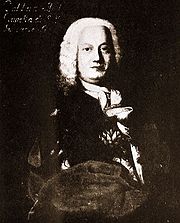
Antonio Caldara
Encyclopedia

Baroque
The Baroque is a period and the style that used exaggerated motion and clear, easily interpreted detail to produce drama, tension, exuberance, and grandeur in sculpture, painting, literature, dance, and music...
composer
Composer
A composer is a person who creates music, either by musical notation or oral tradition, for interpretation and performance, or through direct manipulation of sonic material through electronic media...
.
Caldara was born in Venice (exact date unknown), the son of a violinist. He became a chorister at St Mark's
St Mark's Basilica
The Patriarchal Cathedral Basilica of Saint Mark is the cathedral church of the Roman Catholic Archdiocese of Venice, northern Italy. It is the most famous of the city's churches and one of the best known examples of Byzantine architecture...
in Venice, where he learned several instruments, probably under the instruction of Giovanni Legrenzi
Giovanni Legrenzi
Giovanni Legrenzi was an Italian composer of opera, vocal and instrumental music, and organist, of the Baroque era...
. In 1699 he relocated to Mantua
Mantua
Mantua is a city and comune in Lombardy, Italy and capital of the province of the same name. Mantua's historic power and influence under the Gonzaga family, made it one of the main artistic, cultural and notably musical hubs of Northern Italy and the country as a whole...
, where he became maestro di cappella to the inept Charles IV, Duke of Mantua
Charles IV, Duke of Mantua
Ferdinando Carlo Gonzaga was the only child of Duke Charles II of Mantua and Montferrat, and the last ruler of the Duchy of Mantua of the House of Gonzaga.-Biography:...
, a pensionary of France with a French wife, who took the French side in the War of the Spanish Succession
War of the Spanish Succession
The War of the Spanish Succession was fought among several European powers, including a divided Spain, over the possible unification of the Kingdoms of Spain and France under one Bourbon monarch. As France and Spain were among the most powerful states of Europe, such a unification would have...
. Caldara removed from Mantua in 1707, after the French were expelled from Italy, then moved on to Barcelona as chamber composer to Charles VI of Austria, the pretender to the Spanish throne who kept a royal court at Barcelona. There, he wrote some operas that are the first Italian operas performed in Spain. He moved on to Rome, becoming maestro di cappella to Francesco Maria Marescotti Ruspoli, 1st Prince of Cerveteri
Francesco Maria Marescotti Ruspoli, 1st Prince of Cerveteri
Francesco Maria Marescotti, Principe Ruspoli was the ?th Marchese and 1st Principe di Cerveteri, 1st Marchese di Riano and 6th Conte di Vignanello....
. While there he wrote in 1710 La costanza in amor vince l'inganno (Faithfulness in Love Defeats Treachery) for the public theatre at Macerata
Macerata
Macerata is a city and comune in central Italy, the capital of the province of Macerata in the Marche region.The historical city center is located on a hill between the Chienti and Potenza rivers. It consisted of the Picenes city named Ricina, then, after the romanization, Recina and Helvia Recina...
. In 1716, he obtained a similar post in Vienna to serve the Imperial Court, and there he remained until his death.
Caldara is best known as a composer of opera
Opera
Opera is an art form in which singers and musicians perform a dramatic work combining text and musical score, usually in a theatrical setting. Opera incorporates many of the elements of spoken theatre, such as acting, scenery, and costumes and sometimes includes dance...
s, cantata
Cantata
A cantata is a vocal composition with an instrumental accompaniment, typically in several movements, often involving a choir....
s and oratorio
Oratorio
An oratorio is a large musical composition including an orchestra, a choir, and soloists. Like an opera, an oratorio includes the use of a choir, soloists, an ensemble, various distinguishable characters, and arias...
s. Several of his works have libretti
Libretto
A libretto is the text used in an extended musical work such as an opera, operetta, masque, oratorio, cantata, or musical. The term "libretto" is also sometimes used to refer to the text of major liturgical works, such as mass, requiem, and sacred cantata, or even the story line of a...
by Metastasio
Metastasio
Pietro Antonio Domenico Trapassi, better known by his pseudonym of Metastasio, was an Italian poet and librettist, considered the most important writer of opera seria libretti.-Early life:...
.
Noted works
Oratorios- Maddalena ai piedi di Cristo (c. 1700)
- Santo Stefano, primo Re d'Ungheria (1713)
- La Conversione di Clodoveo Re di Francia (1715)
- La passione di Gesù CristoLa passione di Gesù CristoLa Passione di Gesù Cristo is the title of a libretto by Metastasio which was repeatedly set as an azione sacra or oratorio by many composers of the late baroque, "rococo", and early classical period.-Writing and original setting:...
(1730) - Il Re del dolore (1722)
- Stabat Mater (c. 1725)
Others
- "Sebben, crudeleSebben, crudeleSebben, crudele is an aria from Antonio Caldara's 1710 opera La costanza in amor vince l'inganno . Although the opera itself has been rarely performed in modern times, Sebben, crudele remains a popular concert aria...
" (Aria from La costanza in amor vince l'inganno, 1710) - L'OlimpiadeL'OlimpiadeL'Olimpiade is an opera libretto in three acts by Metastasio originally written for Antonio Caldara's 1733 opera. Following Caldara's success, more than 60 baroque and classical composers used the libretto for their own renditions. Metastasio’s plot, draws upon the narrative of '"The Trial of the...
(Opera, 1733) - D'improvviso (Cantata)
- "Pur dicesti, o bocca bella" (Aria)
- "Alma del core" (Aria)
- "Selve amiche" (Aria)
External links
- Biography and works
- List of 85 stage works
- List of recordings, University of CanterburyUniversity of CanterburyThe University of Canterbury , New Zealand's second-oldest university, operates its main campus in the suburb of Ilam in the city of Christchurch, New Zealand...
School of Music

